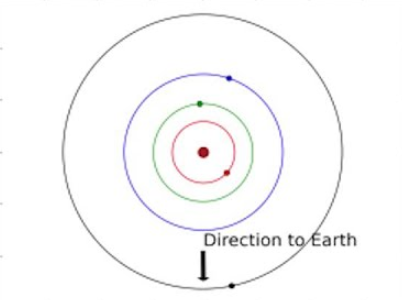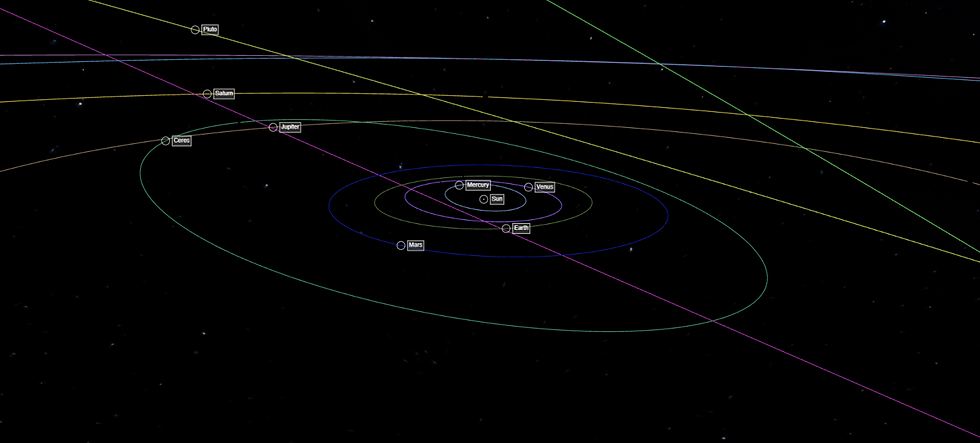What My Astronomy Students Discovered
- Frank Hummer

- Apr 26
- 5 min read
Updated: May 4

This is a simple story of one of the most rewarding teaching moments I ever had.
For most of my teaching career, I have taught math. For four semesters, though, I had the chance to teach a college freshman-level astronomy course. This was at Coe College in Cedar Rapids, Iowa.
Coe College had a telescope with a 6-inch mirror that I wanted to use for a class activity. That's a big enough mirror so that you can do a few things. For one activity we did just "look at the moon," and the students liked that. I wanted to do something more, though. I wanted the students to do some kind of observational exercise. Jupiter was visible in the night sky during the evening class hours of this particular semester. I asked the students to observe through the telescope the four brightest of Jupiter's moons on two nights a few days apart. These are called the Galilean Moons, after their discoverer, Galileo, who pioneered the use of the telescope. The students were to draw their observations on paper. This is what Galileo had to do, almost 400 years earlier.

The students then needed to use whatever visual clues and reference information they had so as to correctly identify the four moons by name: Io, Europa, Ganymede, and Callisto. What were the clues? Really all they had were their subjective estimates of how bright the moons appeared, their apparent distance (angular distance) from Jupiter, and the orbital periods of these moons. The students had it a little easier than did Galileo. First of all, the students' telescope was bigger than Galileo's. Also, Galileo didn't know the actual distances of the moons from Jupiter, or the moons' orbital periods. Galileo had to do all of that work from scratch. Still, the students were required to do some reasoning and calculation. Ganymede and Callisto are the brightest of the moons. That narrowed things down for the students. Callisto, the farthest from Jupiter, can have a small angular distance from Jupiter if they're almost lined up. But Io, the closest to Jupiter, can't have a large angular distance, and so on. For a given angular distance from Jupiter, there is an ambiguity as to whether a particular moon is on the side of the orbit nearer to earth or farther from earth. Observing on different nights does help to resolve this, but the students did only get to use two nights of observational data, whereas Galileo got to take his time across many nights.
I provided the students with a worksheet similar to the one below (but they had to fill in the dots for the moons). The students would be able to take their raw drawings (similar to Galileo's shown above) and, using the clues available, figure out the names of the moons they saw.

How did this exercise go? Very well, really. Almost all the students correctly identified all of the moons, and placed them correctly in their orbits. The students seemed to like this activity. It was as "hands on" as astronomy gets, and they got to go outside. So I felt very good about the exercise. (I had tried this on my own a couple of weeks earlier to make sure that this was even doable and to make sure that at least I could do it! I checked my results against Astronomy Magazine's sky charts.)
Rewarding for me as a teacher? Yeah, sure. But this is not the "most rewarding teaching moment" I mentioned in the first sentence of this post.
The students and I had to wait outdoors a while for their chances to look through the eyepiece of the telescope at Jupiter and its family. I took a few seconds of that time to point out other objects in the sky: Mars, Saturn, of course, Jupiter, and also they could see the Moon was out. Outside of that, there was nothing to do but wait. While we were waiting, I noticed that many of the students were just looking up at the sky. It could have been driven by the love of the universe that I had successfully instilled in them as their astronomy teacher, or it could have been that there was nothing else for them to do out there.
Then two of the students, a young man and a young lady, came up to me to ask a question. The young man spoke with an interesting mix of hesitancy and excitement: "You said that's Mars, and that's Saturn, and there are the Moon and Jupiter. It looks like they're all in a line. Are we seeing the plane of the solar system there?" I just answered "Yes!" Then I held up my arms at a certain angle to suggest the orientation of that plane of the ecliptic, which of course passes through the earth, where we are. The two students had smiles on their faces. Right away another student or two came up to the first two students and me to ask what we were talking about. The information was shared quickly, and there was a wave of skyward-pointing arms moving outward through this class of about thirty students. I could hear students in turn saying "that's the plane of the solar system". This is what a teacher hopes for. All of the students were intrigued upon noticing this. The concept of planets' orbits lying nearly in the same plane is not complicated. I'm sure none of the students had thought I was fibbing when I talked about it in the classroom. Still, making the direct connection between abstract knowledge and personal experience is exciting, and it should be.

The famous biologist Rupert Sheldrake has spoken about his conversations with professional astronomers. He was walking with such an astronomer one evening, and asked the astronomer to tell him the name of a star or some other object of interest that they could both see in the night sky. The astronomer couldn't name it, and he shrugged off the notion that he should even be able to do so. Like so many astronomers, his professional work consisted of analyzing data that other people were collecting, perhaps from telescopes or space probes. The astronomer was probably good at that. Sheldrake thought it was odd, and a little unfortunate, for astronomers to not have an emotional connection to the objects of their studies. The astronomer he was chatting with probably knew a lot about nuclear processes in stars, but he didn't know his way around the sky.
I think, though, that many astronomers do have a sense of wonder and amazement about the universe - that sense that my students showed in astronomy class that night. A feature of the astronomy culture that I find uplifting is the joy many of them seem to get when they tackle the problem of naming the new objects that they find in the sky - asteroids, comets, moons, even craters. They would (nearly?) all scoff at astrology or mythology, but I think they still get a kick out of continuing that project started by ancient astronomers -- the project of naming celestial objects after Greek or Roman gods and such. It feels like an art form.



Comments